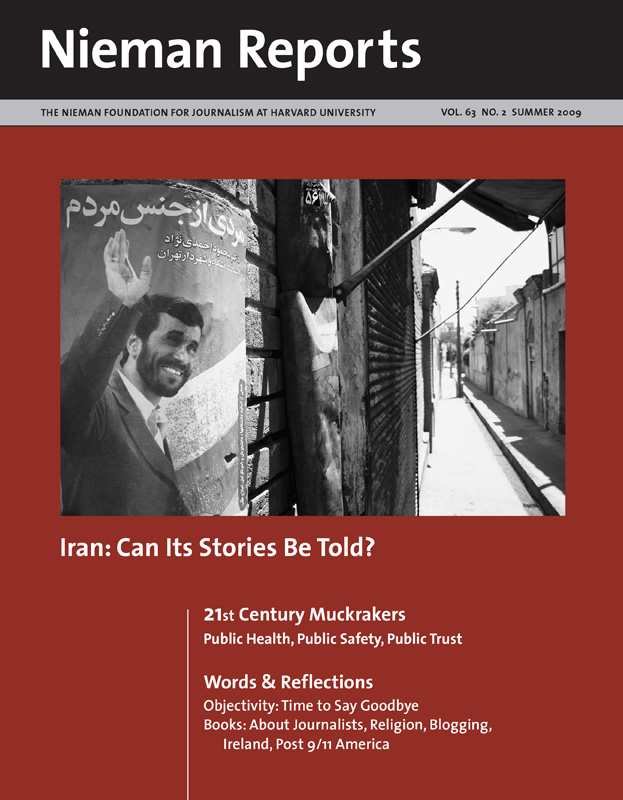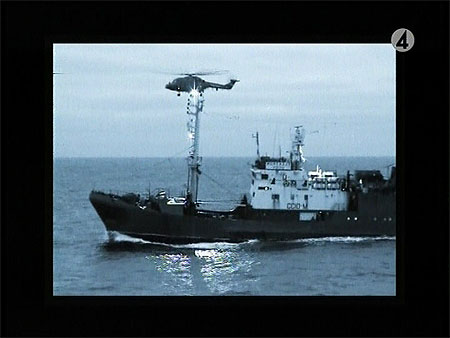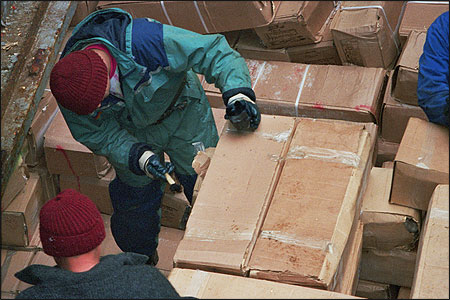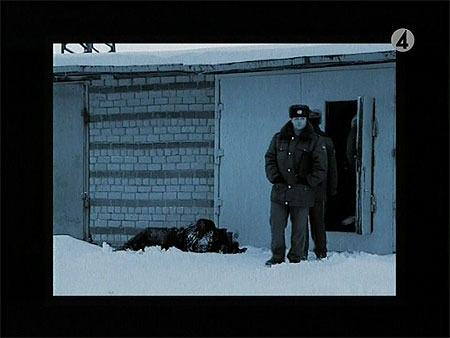
Iran: Can Its Stories Be Told?
Journalists — Iranians and Westerners — share their firsthand experiences as they write about the challenges they confront in gathering and distributing news and information about Iran and its people. Their words and images offer a rare blend of insights about journalists’ lives and work in Iran. In the fifth part of our 21st Century Muckrakers series about investigative and watchdog reporting, the focus turns to coverage of issues involving public health, safety and trust. And in Words & Reflections, essays touch on objectivity, religion, blogging, Ireland and post 9/11 America.

“Jupiter, Jupiter, Jupiter … This is Norwegian Coast Guard vessel KV Harstad on Channel 16. We request to come on board for an inspection. Prepare a pilot ladder on the starboard side and reduce speed to 3 knots.”
The freezing northern winds blow with winter harshness causing the seas to roll and crash with ferocity. As reporters with Swedish National TV4, we are on board the KV Harstad, the Norwegian Coast Guard’s ultra modern vessel—a part of our journey to investigate the rise in illegal fish poaching in the Barents Sea. It’s been two days since we left the vessel’s base in north Norwegian Sortland, and we are now in the western part of the Coast Guard’s working area. The search areas are vast—the Barents Sea covers an area as large as Western Europe—and the vessel’s course is directed from ashore where an operation center compiles relevant data about the location of suspected fish poachers.
Our ship’s mission is to locate and inspect Russian ships that are catching, transferring and transporting fish (mainly cod) from fishing zones in the north to harbors along the European west coast. For us, this trip is part of our investigative effort to illuminate the illegal fishing practices that are damaging the fishing waters off our country’s shore.
For us, this trip is part of our investigative effort to illuminate the illegal fishing practices that are threatening the last stable stocks of cod on earth. Stocks of cod in Newfoundland, the Baltic, and the North Sea have all collapsed or diminished. There is one place where the stocks seem healthy—in the Barents Sea between Norway, Russia and Spitsbergen, an island in the Arctic Ocean. The current scientific advice says that a maximum of 400,000 tons of cod can be fished per year from the Barents Sea without threatening the regeneration of the stock. But according to our sources, more than 500,000 tons is landed each year, and this means that massive overfishing is happening.
The commander of KV Harstad points his searchlight towards the towering silhouette—a Russian flagged refrigeration ship called Jupiter, which is suspected of connections to the illegal “black” fishing. With the aid of an RIB (rigid inflatable boat), the Norwegian inspectors and we will board the vessel to inspect the cargo and check the catch logs.
The atmosphere is extremely tense. Only a few weeks earlier, two Norwegian fishery inspectors were kidnapped by the crew of the Russian trawler Elektron. The Norwegian Coast Guard’s dramatic pursuit was followed on TV screens the world over. A diplomatic crisis ensued and finally ended with the release of the two inspectors once the Elektron reached a Russian port.
“Prepare pilot ladder on starboard side!”
The Norwegian commander’s order is heard over our radio on the RIB as we approach Jupiter. The waves are several meters high. In the deep troughs of the waves we can barely see the hull of the Russian refrigeration ship. An old, worn rope ladder is thrown over the rail. To have any chance of boarding the ship, we have to stand in the very bow of the RIB, wait for the next wave crest, and then jump to the ladder. Our hearts beat fast and hard under the thick survival suit. There is great risk in a jump timed wrong: the propeller whirls, darkness descends, and the biting cold surrounds us in the wind and the water.
“Wait … wait … now. Jump,” a crew member yells, as each of us prepares to leap.

Documenting a Story: Illegal Cod Fishing
Our interest in fish, and particularly in codfish, started several years earlier. After tips from maritime researchers in Sweden, we decided to investigate the occurrence of fish poaching—more specifically illegal fishing outside the fixed fishing quotas in the Baltic Sea. Back then, in 2002, no one wanted to speak about this problem—not professional fishermen, not the Swedish Coast Guard, and not the retailers that sold the cod.
Our only way into this closed fishing industry was to form a phony trading company and begin trading with Baltic Cod. In this way we managed to uncover the drastic extent of illegal fishing. Most of the big food chains in Sweden, we learned, were involved in one way or another. The manager of one of the biggest filleting plants that made cod products under subcontract for Swedish Coop (the second biggest food chain in Sweden) admitted (in front of a hidden camera) that up to 50 percent of the cod they bought was “black.”
The reaction to our televised story was overwhelming. Large parts of the Swedish retail businesses began to boycott frozen cod from the Baltic and announced that they would purchase their fish from Norway and Barents Sea instead. But within a couple of years, the sale of cod in Sweden had picked up again—with promises that the industry had learned its lesson. Or so the retailers claimed. “The frozen cod you can buy in Sweden comes from Barents Sea, and it is fished in accordance with scientists’ recommendations and guidelines. You can be absolutely sure it isn’t poached,” declared Yngve Björkman, chairman of the Federation of Swedish Fish Industries and Trade.
Such guarantees aside, we started to follow coverage of poaching in the Barents Sea that was appearing in the Norwegian news media. This was the last outpost of the cod fishing industry. This coverage showed that the Norwegian Coast Guard, unlike the Swedish one, was strongly committed to trying to chart the fish poaching, as was the Norwegian Directorate of Fisheries. During the past four years, these two authorities had charted how many fish had been caught, and their results were frightening.
In Barents Sea, an extra 100,000 tons of fish had been caught on top of the allowed quota every year. The initial value of poaching at sea was calculated at more than one billion Swedish crowns (more than $123 million dollars), and the final value once the fish was sold to consumers was much higher. “These are not poor fishermen, this is big business, and there is much money in circulation. It’s organized crime,” said Stig Flått, a fishery officer in the Norwegian Coast Guard. Most of the fish poaching was being done by Russian fishermen, but the fish didn’t end up in Murmansk or Moscow. Often, these Russian industrial trawlers turned out to be entirely or partly controlled by Western interests.
Our key question was an obvious one: If the majority of all frozen cod products being sold in Swedish shops come from the Barents Sea, are these poached cod? We know that 20 percent of the catch is illegal. But how could we tell a poached cod from one that was legally caught? We couldn’t see the difference, nor taste it, and the price was the same by the time the fish reached the counter. And we knew that asking the producers, wholesalers and retailers was futile. “We absolutely do not buy ‘black’ fish! Not what we … Absolutely not!” responded Inger Larsson, quality manager at Findus, one of the Swedish market’s biggest food producers, when we asked.
To do this story, we decided to chart the flow of all frozen cod products being sold in Swedish shops and to restaurants and schools. With the help of markings on packages, questions to fish companies, searches in public registers, consignment notes and contacts with authorities in more than 10 countries, for several months we attempted to trace the origins of cod products. Only we did this by moving backwards—from store counters to fishing vessels.
At first, we visited many shops and, with the help of camera and notebook, we started to register all of the cod products we could find with notes about their origin and processing plants. Soon we had a list of several hundred products containing cod from the Barents Sea. Our next step was to determine the retailer of each product and from where the product had been bought and where it had been processed. What plant and when? Which agent had sold the cod to that plant? Where did the agent buy the fish? And which boat had caught the cod and when?
Here is what our charting helped us reveal:
- A large proportion of the frozen cod that was fished in the Barents Sea was then sold in Sweden.
- Much of these fish products, however, had made a long detour via China—more precisely through Qingdao Province. There the fish were thawed, filleted by cheap labor, packaged and then frozen again, before being transported back to Europe and the Swedish freezer counters.
In time, we were able to compile a long list of the trawlers who delivered cod to the Swedish market. Our next step was to investigate whether these boats poached fish.

At Sea—To Tell the Story
Now, here we were, again preparing to leap from our RIB in these choppy cold seas onto the Russian freezer ship. Fortunately, the rope ladder held and, pumped full of adrenalin, we were at last on board, and the Jupiter’s captain was offering us vodka and cigarettes in his dirty cabin. He made it clear that he regarded the Norwegian inspection as completely unnecessary. Everything is in order, he assured the Norwegian fishing inspectors, who politely but firmly told him that they wanted to see all documents. Not only the ones that concerned this cargo but earlier ones, too.
“Do you know where the last cargo of cod landed?” the Norwegian fishing inspectors asked.
“Previous captain … He signed off … He took with him … all reports,” the captain answered.
In the Barents Sea, we knew that the Russian factory trawlers mostly transfer the cod to refrigeration ships, like the Jupiter, which go to ports such as Grimsby, in England; Hirtshals, in Denmark; Bremerhaven, in Germany; Aveiro, in Portugal, or Eemshaven, in Holland. There, the catch is unloaded. Transports to foreign ports are not illegal; there is nothing that compels the Russian trawlers to leave their fish in Russian or even Norwegian ports. Of course the question remains: What motivates this extra sea voyage lasting more than a week?
We knew the answer—and we knew we wouldn’t hear it today. In Russia and Norway, the fishing vessels risk being inspected by officials who check the boats’ quotas, thereby distinguishing between legally and illegally caught cod. In other European ports, the cod is treated like any other merchandise. The catch is off-loaded and passed on without any knowledge about fishing vessels’ quotas. It is therefore evidently worth the trouble to reload one or even two times at sea to have the catch transported to “safe” harbors in bigger refrigeration ships.
When the Jupiter inspection ends an hour later, we head back the same terrible way we came up. As we clumsily disappear across the rail, the captain eyes us as he stands smugly on the bridge.
To Russia—To Find the Boats
In December 2005, we traveled to Murmansk, Russia, the base for Barents Sea fishing. It’s bitter cold and our photographer is suffering from food poisoning. We are here with Dima Litvinov, who has worked in the region for Greenpeace for a long time and has contacts and entries into the Russian fishing industry apparatus. Our intention is to find out if the trawlers on our list have been poaching fish.
We’d compiled our list of fishing and transport vessels by charting satellite identities of their locations and call signals. We’d used bills of landing, inspection protocols, catch-landing protocols, and a commercial net service that accounts for reported catches. By doing this, we’d managed to chart how much cod the big factory trawlers have caught and delivered. But for us to prove that they have poached, we must know the size of the quota each trawler was given and what catch they’d reported to the authorities here in Murmansk.
In this quest resides our problem: The information is classified.
Yet plenty is at stake in finding the answer. Each year at least two people are murdered in Murmansk as a result of the fight for revenues from illegal fishing in the Barents Sea. With this danger in mind, it is understandable why few people are willing to speak with us. But after a few days, our perseverance pays off: We have a breakthrough when we are allowed a meeting with a key person in the fishery authorities. We leave the camera in the car outside but take a hidden transmitter microphone with us.
“Understand me right. I’ll help with everything, but I don’t want publicity. My job is to ensure the state’s interest against fish poaching, and that is done today. It is well organized,” he says to us, referring to the ways in which quotes are routinely exceeded. “As an example, I can tell about some companies who had a quota of 200 tons, which you can fish in a week, but they went to sea with that quota for a whole year.”
This source also gave us access to the Russian boats’ latest quotas. His new information tallied with older data about quotas we’d received from official sources in Norway.
When we got back to Stockholm, we worked on doing the math. The essential equation was this one: how much cod had each trawler caught vs. what their quota was during the same period. Here are a few examples:
- Factory trawler Koyda: Documented delivery 1,204 tons of cod, according to Norwegian authorities. Official quota: 479 tons, according to the Russian source. A difference of 725 tons.
- Factory trawler Eridan: Delivery 1,121 tons. Quota 291. A difference of 830 tons.
And so it continued—boat after boat, fabrication after fabrication.
Exactly how much illegally fished cod is sold in Sweden can’t be established with certainty. But one thing is absolutely clear: The nation’s big food suppliers’ guarantee proved to be worthless.
Our investigation—and the two-part report, “The Illegal Cod,” broadcast in January 2006 on Swedish TV4’s program “Kalla Fakta” (Cold Facts)—had some major results:
- Several companies who traded with poaching trawlers (Findus, for example) immediately ceased doing business with them.
- Several Swedish food chains, after internal investigations, changed their suppliers of cod or changed their internal ways of controlling the delivery of fish.
- The Swedish and Norwegian fishery ministers joined forces and brought the matter to the EU Commission for immediate attention, and finally the EU, after years of handwringing, managed to enforce its rules on control of ports, and the illegal landings in mainland Europe came to a halt.
- By September 2006, promises had been made by a number of key countries to report on the deliveries of cod taking place in their ports.
- The Danish police’s economic crime unit began a preliminary investigation against one of the big wholesalers in Denmark.
- Environment organizations like World Wildlife Federation and Greenpeace took actions against the companies and authorities involved. Two years later, the Norwegian fisheries authorities reported that due to the decrease in illegal fishing, the increased value of legally landed fish was some $300 million.
In the winter of 2006 on the Barents Sea, an object was picked up by the searchlight. It was a ship, and soon the Norwegian Coast Guard was requesting it to lower speed so it could be inspected.
“Inna Gusenkova!,” called the commander of KV Harstad.
Just like the last time. Our RIB trip to the Russian ship was just as dark and bouncy, and our jump to the pilot ladder just as terrifying.
“Do you know who the buyer is?” the inspector asked, after he’d looked through the documents on board.
“Agent take the fish … I have no problem … agent give me papers … I don’t need to know more information …” the captain answered, then continued. “I do my work and no more. If you know less, you will live longer.”
Sven Bergman, Joachim Dyfvermark, and Fredrik Laurin have worked as freelance investigative reporters for more than a decade and as a reporting/producing team since 2000. “The Illegal Cod” was broadcast on Swedish National TV4 in September 2008, and it won The International Consortium of International Journalists’ Daniel Pearl Award for the best investigation by an international medium. For their reporting of the 2004 story, “Extraordinary Rendition,” which revealed the top-secret deportation from Sweden of two Egyptian men by masked American agents, they received many awards, including the Stora Journalistpriset, the Swedish equivalent of the Pulitzer Prize.